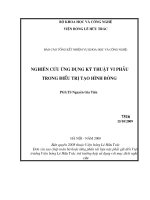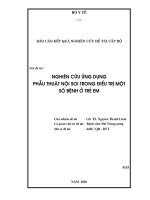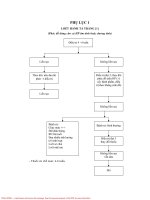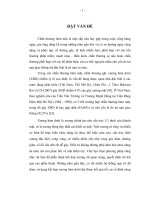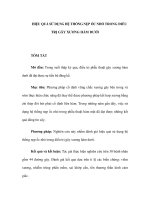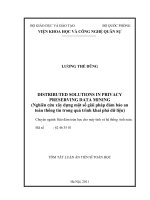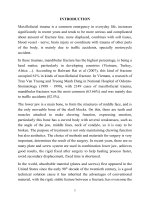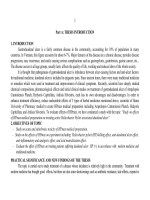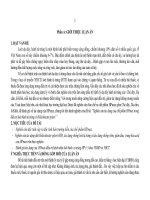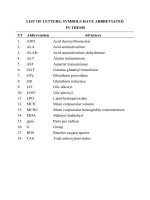nghiên cứu áp dụng nẹp vít tự tiêu trong điều trị gãy xương hàm dưới bản tóm tắt tiếng anh
Bạn đang xem bản rút gọn của tài liệu. Xem và tải ngay bản đầy đủ của tài liệu tại đây (172.34 KB, 24 trang )
INTRODUCTION
Maxillofacial trauma is a common emergency in everyday life, increases
significantly in recent years and tends to be more serious and complicated
about amount of fracture line, more displaced, combines with soft tissue,
blood vessel - nerve, brain injury or coordinate with trauma of other parts
of the body, is mainly due to traffic accidents, specially motorcycle
accident.
In these traumas, mandibular fracture has the highest percentage, is being a
heed matter, particularly in developing countries (Vietnam, Turkey,
Africa ). According to Balwant Rai et al (2007), this kind of fracture
occupied 61% in kinds of maxillofacial fracture. In Vietnam, a research of
Tran Van Truong and Truong Manh Dung in National Hospital of Odonto-
Stomatology (1988 - 1998), with 2149 cases of maxillofacial trauma,
mandibular fractures was the most common (63.66%) and was mainly due
to traffic accidents (82.5%).
The lower jaw is a main bone, to form the structures of middle face, and is
the only moveable bone of the skull blocks. On this, there are teeth and
muscles attached to make chewing function, expressing emotion,
particularly this bone has a curved body with several weaknesses, such as
the angle of the jaw, middle lines, neck of condyle, so it is easy to be
broken. The purpose of treatment is not only maintaining chewing function
but also aesthetics. The choice of methods and materials for surgery is very
important, determines the result of the surgery. In recent years, there are so
many plate and screw system are used in combination lower jaw, achieves
good results, the rigid fixed after surgery to help healing process faster,
avoid secondary displacement, fixed time is shortened.
In the world, absorbable material (plates and screws) first appeared in the
United States since the early 90
th
decade of the twentieth century, is a good
technical solution cause it has inherited the advantages of conventional
material, with the rigid, stable feature between a fracture; has overcome the
1
disadvantages of removing the screw and bands for patients to avoid the
secondary surgery, both economical cost, time -consuming as well as bad
scars, affects the aesthetics and psychology of the patient. In addition,
absorbable screw can play a same role as tissues when being treated by
radiation therapy after surgery, another benefit is the ability of
transparency, easy for diagnosis postoperative X-ray imagines. In pediatric
patients, treatment and orthopedic surgery becomes easier because they do
not prevent the development of bone.
Today, this system has highly compatible feature, is being widely used and
prospectively an ideal treatment for trauma, especially be good for children
or maxilla. However, the existed problem for some developing countries is
still high cost. Initially, absorbable material only uses limitedly in brain
surgery (such as craniosynostosis, brain hernia), then in combination
between the middle-level facial bone and orthopedic surgery. With the
mandible, they also doubt the effectiveness of this material, recently there
is few reports shows the success of using absorbable screws in the lower
jaw surgery.
In Vietnam, absorbable material is put into use in recent years, however, it
is on trial, and the amount of research is not enough. So that, in order to
study and apply and technology of combination the mandible by
absorbable material, we did a research: "Applying absorbable material on
mandibular fracture treatment" with the two following goals:
1. Comment on the clinical morphologic of mandibular fractures.
2. Review the result of the technology of fixing the mandible by
absorbable material, compare with Titanium material.
* Layout of the thesis
The thesis consists of 99 pages, 2 pages for introduction and 2 pages for
conclusion. This includes four chapters: Chapter 1 about literature review
has 38 pages, chapters 2 about subjects and methods has 14 pages, chapter
2
3 about research result has 20 pages, chapter 4 about discussions has 24
pages. There are 36 tables, 6 charts and 20 figure, 102 book references: 32
Vietnamese ones, 66 English ones, 4 French ones. The appendix includes
illustrations of patients, medical records, patient list.
* Meaning and new contributions of the thesis
This method brings the results which is not different from the usage of
Titanium material when having accurate indication.
During doing a research, we found that the application of this method has
some advantages:
- The biggest advantage is that the patient does not have to proceed to the
second surgery to remove the plates and screws, this is significant for
female patients, thereby helping patients quickly regain confidence, do not
have to worry about having to remove the material.
- The material is absolutely preserved in a sterilization condition, in the
process of studying, we have not seen any complications of patients wound
like infection or osteitis.
- This is biomaterials, does not affect the diagnostic imaging (X-ray, MRI).
- About aesthetics: No difference from the usage of Titanium because the
absorbable material does not occupy more volume than the maxi Titanium
plate.
CHAPTER 1. LITERATURE REVIEW
1.1. ANATOMICAL FEATURES OF MANDIBLE RELATE TO
TRAUMA
Mandibular region is formed by two bones, stick together at the centre and
the soft tissues around.
Border: The zygoma and maxillary above, inframandibular edge beneath,
the mental area is ahead, the back of ramus behind.
3
1.1.1. Shape
Mandible is a flat bone, horseshoe-shaped, protruding out frontal surface ,
including 2 parts: body and ramus.
It is porous inside, thick and rigid outside, each side has a tube that the
mandibular nerve and blood vessel go through. There are many tooth
implanted in the cancellous bone .
1.1.2. The weak points of mandible
- Incisal area, mental foramen, gonion, neck of condyle.
1.1.3. The muscles around and the direction of displacement of the fractured bone
These muscles (except the buccinator) are responsible for chewing and
movement, divided into two groups with opposite forces.
* Lifting the mandible:
- Maseter, temporalis muscle, the internal pterygoid.
* Lowering the mandible:
- The external pterygoid, mylohyoid, geniohyoid, genioglossus, the anterior digastrics.
When the bone break, the muscle pulls the fragment towards its own
direction, leads to the displacement. It can be in 3-dimensional space
plane: vertical plane (up and down movement), horizontal plane (right and
left movement), the front vertical plane (twisting).
1.2. CLINICAL SYMPTOMS AND X RAY
1.2.1. Clinic symptoms
a) Swelling and hematoma
b) Discontinuous bone and sharp pain
- These are important signs to diagnose fracture.
4
c) Deformity
d) Discontinuous and displaced dental arch:
d) Malocclusion
e) Mobility of tooth, alveolar bone, gum injury
f) Soft tissue injury:
g) Mandibular movement disorder, including limitation of mouth opening
and deviation to the contralateral.
h) Paraesthesia
i) Subcutaneous emphysema: rare.
1.2.2. X-ray fracture
1.2.2.1. Survey the entire mandible
a) Panoramic films
- The vertical displacement on the bottom can be assessed very good on panoramic
films, in the fracture of neck’s condyle shows the displacement between ahead and
behind, the relationship between condyle and mandibular fossa.
b) Facial X-ray:
- Assess of the horizontal displacement of the fracture, compare with the
proportions of the whole mandible.
1.2.2.2. Films examined the region of the mandible (Oblique jaw film)
1.2.2.3. CT Scanner (CT: Computerized tomography)
To get clarity, accuracy of lesion and location (both bones and soft tissues)
of most mandibular fracture. 3 dimensional images show clearer about
displacement pattern and degree of fracture displacement.
1.3. COORDINATE INJURIES
5
Brain injury has the highest percentage (9.5%), the second is coordinated
with maxillary fracture (5.2%), then zygomatic fractures (2.2%). Injuries
coordinated with other parts such as limbs, chest, abdomen, spine appear
with lower rates.
1.4. TREATMENT
1.4.1. The goal of treatment
- Recovery of anatomy
- Recovery of function
- Recovery aesthetics
1.4.2. Requirements
- Bend fractures corrected
- Fix fracture bones
- Prevent complications.
1.4.3.Fixing by plate and screw
- The basic technique
+ Adjust fractures to the correct position, correct occlusion, temporary
fixation dental archs.
+ Put a sample plate on surface of bone and bend it.
+ Bend the plate following the curve of the sample one.
+ Put the plate on the surface of bone, keep it tightly by pliers, and drill the
first hole on the compressed position (pear shape), off-center position.
+ Screw (not tightened).
+ Drill the second hole in remained compressed position and screw.
6
+ Gradually twist tightly the screws both sides to the most tighten to press
the fracture together.
+ Drill and screw in the middle position.
+ Remove the equipment, check anatomical landmark and occlusion.
After surgery the patient does not have to fix jaws or just fix in a short
time (1-2 weeks).
- Use absorbable material in the treatment:
Absorbable material is easy to use as Titanium and does not need more
surgery to remove due to the process of biodegradation the material
transfer to C0
2
and H
2
O. This process starts after 6 months and lasts on
average 36-60 months by two stages (hydrolysis and absorption) with the
combination of the metabolic cycle of Citric acid (Krebs Cycle ).
- Advantages of absorbable material
It is created from the natural compounds. Not only meets the treatment,
inherits the advantages of the metal plate and screw, but also overcome the
disadvantages of metallic material.
- Indication:
+ Facial and skull fractures.
+ Nasal fracture, anterior walls of sinuses, lateral orbital wall, the floor of
orbital.
+ Replicate the facial bones and skull.
+ Replicate the jaw bone (bone graft).
- Contraindications
+ Acute infection.
7
+ Poor blood supplying in the position which plates are put on, bone
defects, high risk of infection.
+ Not use for high pressure position
+ Temporomandibular joint surgery.
In my research, we use the products of Bio Tech One.
CHAPTER 2
SUBJECTS AND METHODS
2.1. SUBJECTS
The patients have mandibular fracture, are indicated for surgery at the
Department of Orthopedic Surgery in National Hospital of Odonto
Stomatology and Department of Odonto Stomatology, E hospital from
January 2008 to August 2012.
2.1.1. Requirement
- Being diagnosed mandibular fractures with 1 or 2 lines, very little
displaced.
- Combine mandible by absorbable and Titanium material.
- Be volunteer to participate in research.
- Intervention group using absorbable material.
- Control group using Titanium material.
2.1.2. Exclusion
- Mandibular fracture or bone defects due to pathology.
- Plenty of fractures, complex fractures.
8
- Psychiatric patients or chronic diseases affect the bone healing process.
- Uncooperative patients.
2.2. LOCATION AND TIME
Department of maxillary surgery in National hospital of Odonto-
Stomatology and Department of Odonto- Stomatology in E hospital from
January 2008 to August 2012.
2.3. METHODOLOGY
2.3.1. Kind of research
- Clinical controlled intervention trial
2.3.2. Sample
Consists of 60 eligible patients, were divided into two study groups:
absorbable material group has 30 patients (intervention group) and
Titanium group has 30patients (control group).
2.3.3. Information collection:
2.3.3.1. Patient information
2.3.3.2. Clinical
2.3.3.3. Subclinical: X-ray, laboratory
2.3.3.4. Evaluation of treatment results:
* Review the results before discharge (according to Table 2.2):
Table2.2.Standards for evaluating the results of treatment before discharge.
Factor
Result
Hard tissue Soft tissue
Good
- Correct border
- Correct occlusion in the central
occlusion
- No swelling, no deformation
- Incision is dried
- No having the feeling of unpleasant
9
Medium
- A little deviated border
(≤1mm)
- Open bite ≤1mm at the
fracture position
- A little swelling and deformed
- Incision is dried
- A little stimulant at which the plate
was put on, patient feel acceptable
Bad
- Much deviated border (>1mm)
- Open bite >1mm
- Much deformed, need surgery
- Very unpleasant, patients complain
* Review the results after 6 weeks and 3 to 6 months:
Table 2.3. Evaluation based on the standard of anatomy, function and aesthetics.
Degree Anatomy Function Aesthetics
Good
- Good healing
- Good in contact
between two fragments
(displacement < 1mm)
- No pain, eat well
- TMJ moves well
- Amplitude of opening
mouth ≥ 40mm
- Correct occlusion
- Proportional face
- No deformation of
bone and soft tissue
Medium
- Good healing
- Displaced between 2
fragments about
1-2mm
- Less pain, eat
normally
- TMJ normally
- 20mm < Amplitude of
opening mouth < 40mm
- Correct occlusion
- Proportional face
- A little deformation of
bone and soft tissue
Bad
- Bone healing time
lasts longer
- Incorrect healing >
2mm or pseudo- joint
- Need reoperation
- Pain, hard chewing
- Limited TMJ movement
- Amplitude of opening
mouth ≤ 20mm
- Incorrect occlusion
- Need reoperation
- Unproportional face,
deformation of bone and
soft tissue.
- Need reoperation
2.4. ANALYSE THE DATA: Collecting, summarizing data by
biostatistics algorithmic, SPSS 16.0 software.
CHAPTER 3: RESULTS
3.1. CHARACTERISTICS OF SUBJECTS
3.1.1. Gender
10
Regarding gender, men were major, accounted for 81.7% (80% absorbable
group, 83.3% Titanium group), 18.3% of women. Ratio M / F was 4.5.
3.1.2. Cause of injury
The most common injuries were traffic accidents, with a rate of 73.3%
(66.6% in the absorbable group and 80% in Titanium group). In particular,
the traffic accidents group was dominated with motorcycles reason with a
ratio 68.3% (63.3% and 73.3% respectively).
3.1.6. Injured position
Table 3.9. Classification of mandibular fractures by injured position
Group
Position
Absorbable Titanium Total
Amount
Ratio
(%)
Amount
Ratio
(%)
n %
Mental area 13 43,3 8 26,7 21 35
Horizontal
branches
13 43,3 18 60 31 51,7
Angle of jaw 8 26,7 14 46,7 22 36,7
Ramus 0 0 1 3,3 1 1,7
Coronoid process 1 3,3 0 0 1 1,7
Condyle 5 16,7 4 13,3 9 15
Thus, in the absorbable group, mental area and horrizontal branches
accounted for the highest percentage (43.3%). In the Titanium group,
horizontal branches and angle of jaw fractures were major with the ratio of
60% and 46.7% respectively.
3.1.7. The amount of fracture
Table 3.10. Classification of mandibular fractures by the amount of fracture
Group
Absorbable Titanium Total
11
Amount of
fracture lines
Amount
Ratio
(%)
Amount Amount
Ratio
(%)
Amount
1 18 60 10 33,3 28 46,7
2 11 36,7 19 63,4 30 50
3 1 3,3 1 3,3 2 3,3
Total 30 100 30 100 60 100
1 fracture line was major in the absorbable group, 2 fracture lines was
major in the other with the ratio of 60% and 63.4% respectively. 3 fracture
lines had the same rate in both groups.
3.1.8. Attached injuries: Table 3.11. Attached injuries
Group
Attached injuries
Absorbable Titanium Total
Amount
Ratio
(%)
Amount
Ratio
(%)
Amount
Ratio
(%)
Mandibular fracture
alone
25 83,3 19 63,3 44 73,3
Mandibular +
zygomatic arch
fracture
2 6,7 2 6,7 4 6,7
Mandibular +
maxillary fracture
0 0 2 6,7 2 3,3
Limb, joint injuries
2 6,7 3 10 5 8,3
Brain injury
(contusions , brain
hemorrhage,
subarachnoid
hemorrhage…)
1 3,3 4 13,3 5 8,3
Total 30 100% 30 100% 60 100
Most cases were mandibular fractures alone (73.3%), 83.3% was
absorbable group, 67% Titanium groups. Mandibular fracture coordinates
with other bones (zygomatic arch and mandible) accounted for 10%. The
12
coordination with brain injury accounted for 8.3%, 13.3% for Titanium
group).
3.1.9. Clinical symptoms: Table 3.5.Clinical symptoms.
Group
Symptom
Absorbable Titanium Total
Amount
Ratio
(%)
Amount
Ratio
(%)
n %
Swelling, bruising 25 83,3 27 90 53 88,3
Sharp pain 30 100 30 100 60 100
Malocclusion 21 70 23 76,7 44 73,3
Uncontinuous
dental arch
19 63,3 22 73,3 41 68,3
Gummy tear 17 56,7 18 60 35 58,3
Limited opening
mouth
15 50 16 53,3 31 51,7
Soft tissue injury 13 43,3 17 56,7 30 50
Comment: There was the sharp pain signs in 100% of the 2 groups,
swelling and bruising signs appeared > 80% of cases and malocclusion>
70%.
3.2. TREATMENT RESULTS
3.2.1. Evaluation of treatment result by time:
a / Treatment result after discharge
Table 3.18. Evaluation results at discharge
13
Group
Result
Absorbable Titanium
p
Amount
Ratio
(%)
Amount
Ratio
(%)
Good
24 80 23 76,7
>0,05
Medium
6 20 7 23,3
Bad
0 0 0 0
Total 30 100% 30 100%
Good results after discharge reached 80% in the absorbable group and
76.7% in Titanium group. Percentage of patients with good results was
20% (absorbable group) and 23.3% (Titanium group). When using Chi
squared test shows no difference statistically with p> 0.05 (X
2
= 0.098 <
X
2
0,95
= 3.84). None of the patients has a bad result.
b / Mandibular fracture results after 6 weeks:
Table 3.22. Assessment after 6 weeks
Group
Result
Absorbable Titanium
p
Amount
Ratio
(%)
Amount
Ratio
(%)
Good 23 88,5 21 84
>0,05
Medium 3 11,5 4 16
Bad 0 0 0 0
Total 26 100% 25 100%
Percentage of patients with good result was higher than the one of
discharge result, with the rate of 88.5% and 84% in absorbable and
Titanium group respectively. The results decreased gradually, only 11.5%
and 16% in absorbable and Titanium group respectively. The Chi squared
test showed no difference statistically with p> 0.05 (X
2
= 0.22 < X
2
0,95
=
3,84).
14
c / Results after 3-6 months: Table 3.23. Assessment after 3-6 months
Group
Result
Absorbable Titanium
p
Amount
Ratio
(%)
Amount
Ratio
(%)
Good 22 95,7 18 90
>0,05
Medium 1 4,3 2 10
Bad 0 0 0 0
Total 23 100% 20 100%
Good results occupied high rate: 95.7% (absorbable group) and 90%
(Titanium group) because all patients were removed the jaw fixation and
guided opening mouth.
In absorbable group, there was 1 case has the medium result and in
Titanium group has 2 cases with medium one due to bad scars, slightly
malocclusion (in patients with complex injuries: neck’s condyle, Lefort ).
The Chi squared test showed no difference statistically with p> 0.05 (X
2
=
0.52 < X
2
0,95
= 3,84).
3.2.2. Assessment results for the purpose of treatment.
a / Evaluation of anatomy
Table 3.24. Evaluating the results of surgery
Time
Result
6 weeks 3-6 months
Absorbable Titanium Absorbable Titanium
Good
24
(92,3%)
22
(88%)
23
(100%)
19
(95%)
Medium
2
(7,7%)
3
(12%)
0
1
(5%)
Bad 0 0 0 0
15
Total 26 25 23 20
B. Assessment of function
To evaluate the functional results, we applied the following standards:
amplitude of opening mouth, chewing, and patient’s feelings at the surgical
position. Result of the function is only evaluated since the beginning of the sixth
month.
Table 3.25. Assessment of function
Time
Result
6 weeks 3 - 6 months
Absorbable Titanium Absorbable Titanium
Good 23
(88,5%)
22
(88%)
23
(100%)
19
(95%)
Medium 3
(11,5%)
3
(12%)
0
1
(5%)
Bad
0 0 0 0
Total
26 25 23 20
Good results after 6 weeks: 88.5% (absorbable group) and 88% (Titanium
group), after 3-6 months increased to 100% (absorbable group) and 95%
(Titanium group). After 6 months of treatment and guiding opening mouth,
there was still 1 case in Titanium group opening mouth limitedly due to the
patients moving from the other subregional hospital.
c / Evaluation of aesthetics
Table 3.26. Evaluation of aesthetic results
Time
Result
6 weeks 3 - 6 months
Absorbable Titanium Absorbable Titanium
Good
21
(80,8%)
19
(76%)
22
(95,7%)
18
(90%)
Medium
5
(19,2%)
6
(24%)
1
(4,3%)
2
(10%)
16
Bad 0 0 0 0
Total 26 25 23 20
Good result increase after 6 weeks and 3-6 months with 80.8% (absorbable
group), 76% (Titanium group) and 95.7% (absorbable group), 90%
(Titanium group) respectively. The medium results increased after 3-6
months to 4.3% (absorbable group) and 10% (Titanium group), due to injuries and
lack of soft tissues.
3.2.3 Accidents, complications: Table 3.27. Complication
Group
Complications
Absorbable Titanium
Amount Ratio (%) Amount Ratio (%)
Accident
- Screw fracture 1 3,3 0 0
- Plate fracture 1 3,3 0 0
Complication
- Inflammatory 0 0 1 3,3
- Allergy 0 0 1 3,3
Total 2 6,6 2 6,6
There were 2 patients of absorbable groups with screw and plate fracture
during surgery, 2 Titanium patients had inflammatory and allergy after
surgery and having medical treatment, no reoperation. No cases reacted
with absorbable material.
Chapter 4: DISCUSSION
Over the period from January 2008 to August 2012, 60 mandibular fracture
patients included 30 patients treated with absorbable material and 30
patients were treated with Titanium at the Department of Orthopedic
Surgery in National Hospital of Odonto-Stomatology and Department of
Odonto Stomatology, we have some conclusions as follows:
17
4.1. POSITION AND AMOUNT OF PLATES
In this study, in absorbable group, we used 53 plates, the rate of plates /
the amounts of fractures line was 53/43 = 1.23 (Table 3.10), Titanium
groups using 68 plates, the rate of plates/ the amounts of fractures line was
68/51 = 1.33.
- In absorbable group, the most fixation position was mental area, up to
33.3%, followed by 26.7% horizontal branches. And the number of plates
used mainly 2 plates (50%), 1 plate (36.7%).
- In Titanium group: fractures of 2 position at horizontal branch and
angle of jaw was highest with the rate of 23.3%, followed by a
combination of 1 position in the horizontal branches (13.3%) and the angle
of jaw (13, 3%). Besides, the percentage of combination of 3 positions was
16.7% with the attached injuries at the horizontal branches, angle of jaw,
and zygomatic arch and maxilla. Therefore, the rate of using more than 2
plates accounted for 83.3% Titanium bands is very suitable.
4.2. CLINICAL SYMPTOMS
Discontinuous bone and sharp pain signs are detected when palpation
along the border of mandible, this is a very important sign to help diagnose
fractures. In my research, these signs appeared in most patients with the
highest percentage of 100%. In the early days when the swelling prevents
from detecting the discontinuous bone sign, but always has the sharp pain
sign in the fracture position.
4.3. ASSESS THE RESULT
The aim of treatment was to restore the mandible as best as possible about
anatomy, chewing function and aesthetics for the patient later.
4.3.1. Assessment by time:
a. Treatment result at discharge
18
- Evaluate overall results at discharge
Good result was 80% in the absorbable and 76.7% in Titanium group. The
medium result was 20% in absorbable group and 23.3% in Titanium group,
because the incision was slightly swollen, mild irritation in the position
which the place was put on, fractures in the patients have neck of condyle
fracture, break angle of jaw coordinate with horizontal branches or the
mental area, but patients came late or attaching brain injury. The difference
was not statistically meaning with p> 0.05. No bad results because at this
stage had not yet assessed bone healing process in both clinical and
radiological.
b. Treatment results after 6 weeks:
After 6 weeks after discharge, the amount of patients coming back was 26
and 25 in absorbable and Titanium group respectively. In my research,
almost patients have been removed the jaw fixation since fortnight, the
proportion of patients achieving good results was 86.3% (44/51 patients),
in these, the results of absorbable group was 88.5% and Titanium was
84%, equivalent with p> 0.05. The medium result was 13.7%, the majority
of these patients had coordinate injuries. No bad results after 6 weeks of
treatment.
c. Treatment results after 3-6 months:
After 3-6 months the evaluation of anatomy, function and aesthetics in
patients was more accurate because the swollen of soft tissues was better.
The amount of re-examination patients was 43 (23 in absorbable group and
20 in Titanium group), good results was 93% (40/43 patients), and was
equivalent between 2 groups. Some patients open mouth at the medium
level at 6 weeks, had better results after 3-6 months practicing. Medium
result was only 6.9% (4.3% in absorbable group, 10% in Titanium group),
due to lacking or crushing of soft tissues, coordination with Lefort fracture
and breaking neck of condyle. In my study there was no bad result.
19
4.3.2. Treatment results according to treatment goals
a. Anatomy:
Good results of surgery after 6 weeks of treatment was quite high, up to
90.2% (46/51 patients), with no difference between the 2 groups, with the
rate in absorbable group was 92.3% and Titanium 88% with p> 0.05. The
medium results was 9.8% (5/51 patients), were the patients had coordinate
injuries.
After 3-6 months the good rate increased, achieved 97.7% (42/43 patients),
2.3% was the medium result. 100% of absorbable group after 3-6 months
had good result.
b. Functions: Assessment of function started 6 weeks after surgery, by the
pronunciation, chewing soft foods, doing the relevant functions, the ability
to use dentures if any …
Good results after 6 weeks was 88.2% (45/51 patients), similar results
between the 2 groups, in absorbable group (88.5%) and Titanium (88%).
The medium result was 11.8%, including the case having attached injuries
coordinate with the different fracture of the mandible and facial bones
(maxillary and zygomatic arch), patients mostly complain about not feeling
normal while chewing, discomfort with the broken position of condyle,
mouth open is not good.
3-6 months after treatment, good results increased 97.7% (42/43 patients),
medium result dropped to 2.3% (after 6 months and opening mouth
practice exercise, 1 case in Titanium group, had limited mouth opening in
the patient moved from the other hospital.
c. Aesthetics:
After 6 weeks of treatment, good results achieved on average 78.4%
(40/51 patients), in which good results in absorbable group was 80.6% and
Titanium was 76%, the difference was not statistically significant with p>
20
0.05. The medium result was 21.6% (11/51 patients), the majority of those
patients combined with other fractures and surgery cases through skin by
old scars, patients often worry about the surgical scar.
After 3-6 good result increased to 93% (40/43 patients), medium result
reduced to of 7%. No bad results because no bad scar made patients
complain or surgery to repair scarring.
4.4. COMPLICATIONS:
According to author Robert and Ramond, the most common complications
of mandibular fracture was bone infection and osteitis. In 60 patients, the
rate of accident and complication is 6.7% (4/60 patients).
Absorbable group: No postoperative infection and no allergy, no rejection.
Titanium group: There were 2 patients having infectious complications and
allergy reaction, having medical treatment: antibiotics, anti-
inflammatory combination of on-site care, no need more surgery.
In Vietnam, due to many factors such as hygiene, ability to manage
patients and less sense so that the teeth in the fracture line was usually
removed. In the 60 patients, we always paid attention to the broken teeth
located on either sides of the fracture if they were loose with the level 3 or
4 would be extracted then sewing. In some cases, teeth located next to the
broken partly and were still stable and we used keep them and advice
patient to treat after removal of jaw fixation.
To conclude, all the complications of treatment depend on the patient's
objective factors and subjective factors of doctor.
CONCLUSION
After doing research using absorbable material (from January 2008 to
August 2012) with 60 patients diagnosed mandibular fractures including
30 patients treated with absorbable material and 30 patients treated with
Titanium at the Department of Orthopedic Surgery in National Hospital of
21
Odonto-Stomatology and Department of Odonto-Stomatology , we give
some concluding remarks as follows:
1. Clinical morphology of mandibular fractures:
- Major morphology includes:
+ Horizontal branches: 51.7%
+ Mental area: 35%
+ Angle of jaw: 36.7%
+ Neck of condyle: 15%
Most case are mandibular fractures alone (accounting for 73.3%).
- Percentage of mandible fractures having 1 fracture line is 46.7%; 2
fracture lines is 50%, 3 fracture lines is 3.3%.
- Mandibular fractures coordinate with other maxillofacial injuries
accounted for 10%, and coordinate with brain injuries up to 8.3%.
- The typical clinical signs include: sharp pain occupy 100%; bruise and
swelling up to 88.3%, malocclusion accounting for 73.3%; discontinuous
dental arch accounted for 68.3, gummy injuries were 58.3%, limited mouth
opening was 51.7%; external wounds accounted for 50%.
- The main reason due to traffic accidents, occupied to 73.3%.
- Men were more common than women and the age of 19-39 years old
accounted for more than 88%.
2. Review the results of mandibular fractures treated by two methods using
absorbable screws compared to Titanium.
- After surgery for more than 30 surgical patients with absorbable material,
observe postoperative care and complications. In both methods, we found
no difference statistically significant about the treatment result.
22
- Here, we found differences in surgical indications, those of using
absorbable material require more limited, more simple fracture line, little
amount of fracture line, major for horizontal branches fracture (1-2 fracture
lines), or fracture of angle of the jaw was little displaced and crumbling.
- Do not apply absorbable material with the fragmented, much displaced
and lots of defective bone fractures in ramus of mandible, neck of condyle
or brain injuries.
- Can be used for the mandibular fracture, go with the maxillary and
zygomatic arch injuries. In E Hospital, we had 4 cases for the positive
results.
In summary, the use of absorbable material in surgery combination
mandible can bring positive results. However, due to strict technical
requirements, specify and limited indication and higher price so that when
deciding do the surgery, need to explain clearly for the patients and their
family know the benefits of using methods. The most beneficial is not just avoiding
the second surgery. The method using absorbable material can be applied in
the treatment of mandibular fractures.
PROPOSALS
Through this research, we have some recommendations as follows:
- The mandibular fracture treatment with absorbable material brings many
benefits and the results did not differ from the use Titanium when be
diagnosed accurately. Therefore, it is necessary to introduce and replicate
this treatment for the maxillofacial surgery department to cater for the
patients by the best way.
- Absorbable materials we used in the study are imported and high price, in
future should study to produce this product with the low cost to serve lots
23
of patients. Also need more researches in long term with larger sample
sizes.
- Maxillofacial trauma increasing, mainly due to traffic accidents. The
government should improve the quality of traffic safety, such as educating
awareness in traffic, improve the public transport system, encouraging
people to take public transportation, reduce the number of motorcycle,
following traffic law strictly.
24
